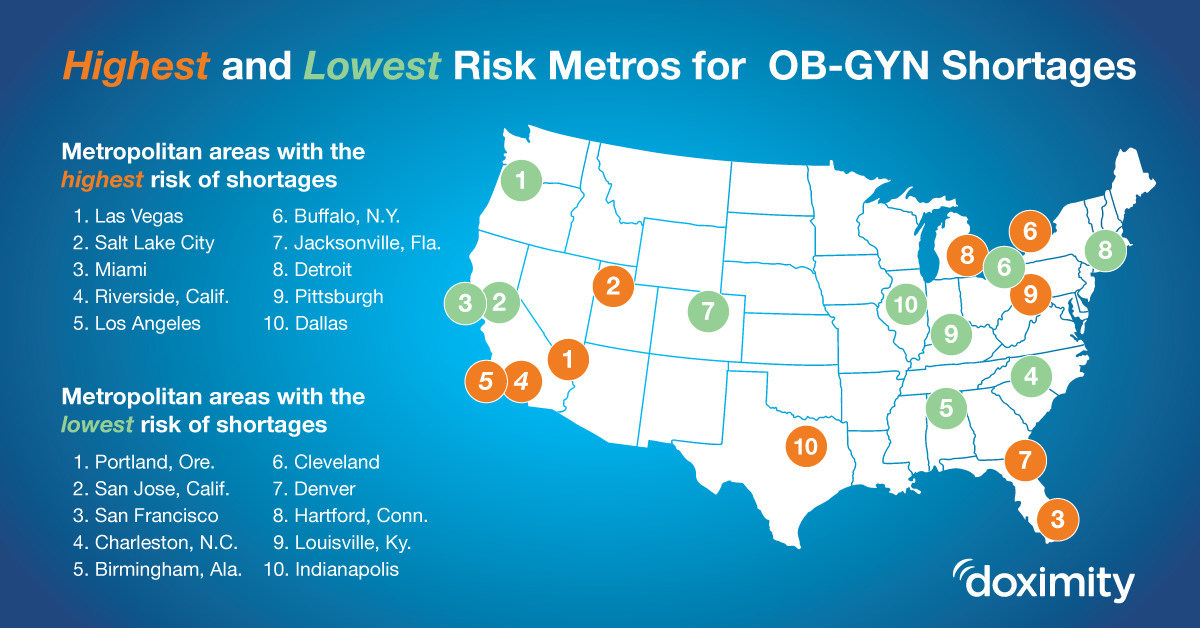Growing U.S. Physician Shortage Hits Maternity Care
Millennial women starting families may face the biggest impact
New research released today shows a growing shortage of obstetricians and gynecologists (OB-GYN) and the potential crisis this poses for women’s healthcare.

Doximity’s “2019 OB-GYN Workforce Study” analyzed the primary factors impacting the specialty on a national and local level, including the percentage of OB-GYNs nearing retirement age, the number of younger practicing OB-GYNs, and maternity workloads. By combining these factors, Doximity researchers created a composite index score to identify the U.S. metros that have the highest risk of OB-GYN shortages.
The new report also examined sources of insurance coverage for live births – private vs. government – to help assess whether compensation is proportionate to growing workloads.
The following MSAs are the top 10 most likely to suffer a shortage of OB-GYNs in coming years:
- Las Vegas
- Salt Lake City
- Miami
- Riverside, Calif.
- Los Angeles
- Buffalo, N.Y.
- Jacksonville, Fla.
- Detroit
- Pittsburgh
- Dallas
New to the report this year, Doximity also examined the sharply declining birthrates in the U.S., as published by the Centers for Disease Control and Prevention (CDC). In 2018, the U.S. birthrate fell to the lowest number in 32 years, but the drop was particularly pronounced for millennial women. In 2017, the total fertility rate was 1,764.5 births per 1,000 women. That represents the largest single-year decline since 2010.
Lingering financial challenges from the Great Recession combined with a shortage of trained OB-GYN specialists may make the goal of having children even harder to reach for millennial women.
“The projected OB-GYN shortages across the nation pose serious concerns for women’s reproductive care. This is particularly concerning for millennials, who are already waiting longer to start a family due to a variety of economic and social factors. Older women are at greater risk of complications during pregnancy, which requires more than average visits with an OB-GYN,” said Amit Phull, M.D. Vice President of Strategy and Insights at Doximity.
Additional findings include:
1. Startling number of OB-GYNs nearing retirement amidst a serious shortage of younger doctors. A large portion of the OB-GYN population is approaching the average age of retirement in many areas of the country. At the same time, none of the metros studied in the report have at least 30 percent of their workforce under the age of 40.
- The metro areas with the highest percentage of OB-GYNs who are 55 years old or above are: Pittsburgh (41); Las Vegas (41); Salt Lake City (40); Virginia Beach, V.A. (39); and New Haven, Conn. (39)
- The metro areas with the lowest percentage of OB-GYNs younger than 40 are: Bridgeport, Conn. (13); Detroit (14); Las Vegas (14); Miami (15); and Buffalo, N.Y. (16)
2. OB-GYN workloads remain high: Despite declining birthrates, OB-GYN workloads remain high. Doximity compared the number of live births with the total number of OB-GYN’s in the top 50 MSAs.
- The metro areas with the largest number of births per OB-GYN are: Riverside, Calif.; Las Vegas; St. Louis; Phoenix; and Dallas
- The metro areas with the lowest OB-GYN workload are: Hartford, Conn.; Bridgeport, Conn.; San Jose, Calif.; New Haven, Conn.; and Portland, Ore.
3. Birthrates are dropping: Of the metros Doximity observed in this study, 42 experienced a declining birth rate, and in most cities, the birthrate among millennials has fallen the most. Many of those same metros are also among the most expensive areas to have a baby – with and without insurance.
- The metro areas with the largest decline in birth rates are: Houston; Portland, Ore.; Salt Lake City; Los Angeles; San Jose, Calif.;
- The metro areas with a slightly growing or stagnant birth rate are: Nashville, Tenn.; Orlando, Fla.; Louisville, Ky.; Atlanta; and Cincinnati
“OB-GYNs provide critical medical services for women throughout their lives. We hope these findings will help healthcare leaders identify ways to address and mitigate potential shortages at regional and national levels,” said Chris Whaley, Ph.D., lead author and adjunct assistant professor at the University of California, Berkeley School of Public Health.
To view the full detailed report, please click here.
Methodology
Doximity’s study is drawn from CMS data, board certification data, and self-reported data on approximately 43,000 full-time, board-certified OB-GYN practitioners. To avoid including retired OB-GYNs, physicians older than 70 were removed from the data set.
Responses were mapped across MSAs, and the top 50 MSAs were selected by population according to 2010 Census data. Population growth data is based on comparisons with Census 2016 population estimates.
The number of births in each metropolitan area comes from the 2015 National Center for Health Statistics and the Centers for Disease Control and Prevention’s WONDER database.
Data on the Medicaid, uninsured, and privately insured population comes from the American Community Survey (ACS). For each MSA, we limited the population to women aged 15-45. We calculated the Medicaid and uninsured rate as the number of women aged 15-45 either enrolled in Medicaid or uninsured relative to the number of women aged 15-45 with private insurance.




